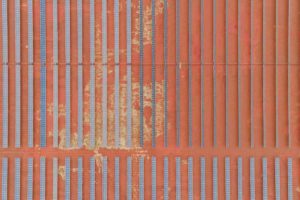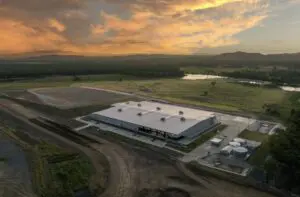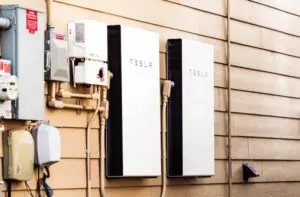Neoen is not the only renewables developer testing out a robot: the contractor at Engie’s Goorambat East solar farm is also trialling autonomous machines, this time for pile driving.
The Build Robotics device started in February and finished installing 1700 piles in mid-April. It secured $1`.3 million in funding from the Australian Renewable Energy Agency (ARENA) in November to fine-tune the system.
The prototype is still significantly slower than using humans, but also much, much quieter than the traditional method of punching piles into the ground, says Bouygues Construction Australia project director Bastien Sauvet.
“You have two machines, both are autonomous. One putting the piles in position and the other one installs and vibrates to put it in a good position,” he told Renew Economy.
“They are not quicker than a team of humans because they did 120 piles per day when on average [with the traditional method] we can do over 250.”
The machines use AI, GPS, and sensor technology to precisely drive piles with minimal human oversight by Sauvet and Equans Solar and Storage which is also running the trial. If a human goes inside a specified perimeter, they automatically shut off to prevent accidents.
A new technique of vibrating piles into the ground rather than hammering reduces noise levels by 20 per cent, Sauvet says.
That’s a detail that will go a long way towards being a good neighbour and to protect nearby workers’ hearing.
Scale ups and desert work
With jobs on the line, the use case for autonomous machines that Suavet, along with Engie’s local representative, Neoen and other renewables developers say they are considering is on bigger projects in areas too harsh for human workers.
The Gurambat East solar farm in Victoria is 250 megawatt (MW), mini when compared to wind farms being proposed today, while Neoen’s Culcairn project in New South Wales is 440 MWp / 350 MW (ac), its second largest solar farm worldwide.
Engie is seeking to build projects that are significantly bigger — as large as 800MW.
But with humans currently needed to lift modules into place (up to four, according to Neoen’s robot supplier, Leapting), to install piles and generally have a hand on each part of the process, the labour needs to build solar projects at that scale while meeting labour regulations will be significant.
Or as one industry source told Renew Economy, for an 800 MW solar project do developers choose to bring in twice the number of people, make the build time twice as long, or just use robots?
A question solar developers are grappling with is that in desert areas, such as Sun Cable is planning with its 20GW of solar south of Darwin and Engie is hoping for with a bid in for an auction of 3GW of solar in Saudi Arabia, is whether those areas are safe for people to work for long periods outdoors.
“We have more projects in desert areas where it’s difficult to get manpower, where the land is huge and the solar farms are bigger and bigger,” Suavet says.
One project, built in the Pilbara, delivered a withering assessment of conditions in remote arid regions. See our story: Hot, humid, dusty and …. boring: Building solar farms in the outback is not piles of fun
The jobs question
The elephant in the room, however, is of course the number of jobs that will be lost to autonomous machines.
The number of jobs created by renewables project construction and ongoing operations and maintenance are now included near the top of both development applications and in government announcements.
That alone suggests any moves to improve efficiency via robots in highly populated regions might run into pushback from communities and from governments trying to sell the renewable energy dream.
Although it should also be pointed out that some of the pushback from local councils is over the question of where and how to accommodate the temporary workforce.
Engie’s Leigh Newbery expects that ultimately a robot like the Build Robotics pile driver will reduce the time it takes to the job and allow work to continue for longer in the day because of the lower noise levels.
“It requires skilled technicians to operate it, thus upskilling the current renewable energy workforce and enabling more productivity,” he said in a statement.
“The intended higher productivity will reduce the cost of renewable energy projects and enable projects to be built in less time – which will bring down energy costs for consumers and potentially allow more renewables to be built.”
When Build Robotics won the ARENA grant last year, the company was firm that people will still be involved in its system but will need bigger skills sets.
The piles still need to be organised onto the machines and configured, then everything taken to the site, the company’s communications lead Lauren Lee told Energy Source & Distribution last year.
Those “robotic equipment operators” are currently Built Robotics trained or the company’s own employees. Lee said they want to create a workforce of people who can operate robotic equipment.








